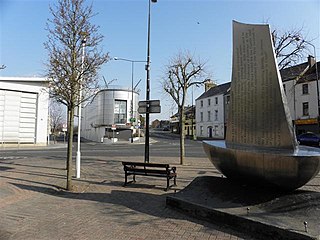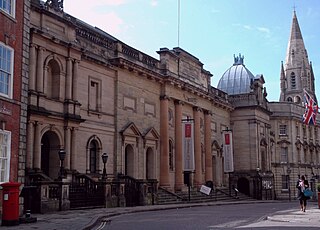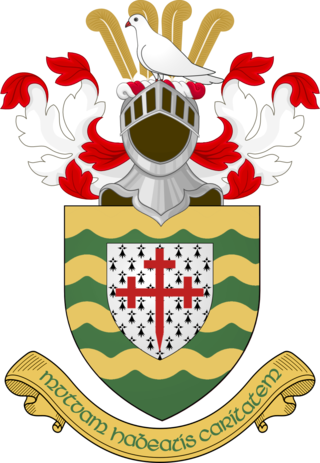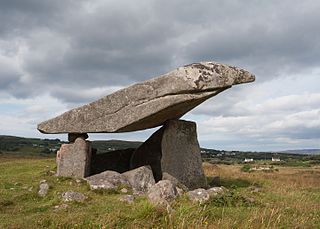
County Donegal is a county of Ireland in the province of Ulster and in the Northern and Western Region. It is named after the town of Donegal in the south of the county. It has also been known as County Tyrconnell, after the historic territory of the same name, on which it was based. Donegal County Council is the local council and Lifford the county town.

Strabane is a town in County Tyrone, Northern Ireland.

Kilmainham Gaol is a former prison in Kilmainham, Dublin, Ireland. It is now a museum run by the Office of Public Works, an agency of the Government of Ireland. Many Irish revolutionaries, including the leaders of the 1916 Easter Rising, were imprisoned and executed in the prison by the orders of the UK Government.

James Napper Tandy was a United Irishman who experienced exile, first in the United States and then in France, for his role in attempting to advance a republican insurrection in Ireland with French assistance.

Lifford is the county town of County Donegal, Ireland, the administrative centre of the county and the seat of Donegal County Council, although the town of Letterkenny is often mistaken as holding this role.

The National Justice Museum is an independent museum on High Pavement in the Lace Market area of Nottingham, England.

Raphoe is a small town in County Donegal in the north-west of Ulster, the northern province in Ireland. It is the main town in the fertile district of East Donegal known as the Laggan, as well as giving its name to the Barony of Raphoe, which was later divided into the baronies of Raphoe North and Raphoe South, as well as to the Roman Catholic Diocese of Raphoe and the Church of Ireland (Anglican) Diocese of Derry and Raphoe.

HMP Belfast, also known as Crumlin Road Gaol, is a former prison situated on the Crumlin Road in north Belfast, Northern Ireland. Since 1996 it is the only remaining Victorian era former prison in Northern Ireland. It is colloquially known as the Crum.

Castlefin, sometimes spelt Castlefinn, is a market town and townland in the Finn Valley of County Donegal in Ulster, the northern province in Ireland. It is located between Ballybofey and Lifford in East Donegal and, as of 2016, the population was 705. The River Finn flows by the town. The town is located in along the main N15 national primary road, which runs from Bundoran to Lifford. The town lies 6 miles from Lifford and 8 miles from the twin towns of Ballybofey and Stranorlar. It has close links to Letterkenny, to the twin towns of Ballybofey and Stranorlar, and to West Tyrone in Northern Ireland, especially with the towns of Strabane and Castlederg.

Donegal County Council is the authority responsible for local government in County Donegal, Ireland. As a county council, it is governed by the Local Government Act 2001. The council is responsible for housing and community, roads and transportation, urban planning and development, amenity and culture, and environment. It has 37 elected members. Elections are held every five years and are by single transferable vote. The head of the council has the title of Cathaoirleach (Chairperson). The county administration is headed by a Chief Executive, John McLaughlin. The county town is Lifford.
Trevor Hamilton, is a Northern Irish murderer.
John MacNaghten (1722–1761), known as Half-Hanged MacNaghten, was an Anglo-Irish land owner, gambler and convicted murderer. The more romantic versions of the tale portray MacNaghten's victim Mary Ann as his lover whose marriage was forbidden by her over-bearing father.

Courthouse Place, also known as the Cook County Criminal Court Building, is a Richardsonian Romanesque-style building at 54 West Hubbard Street in the Near North Side of Chicago. Now an office building, it originally served as a noted courthouse. Designed by architect Otto H. Matz and completed in 1893, it replaced and reused material from the earlier 1874 criminal courthouse at this site. The complex included in addition to the successive courthouses, the Cook County Jail, and a hanging gallows for prisoners sentenced to death. By the 1920s the attached jail, which was behind the courthouse and no longer exists, had a capacity for 1200 inmates but sometimes housed twice that and the court rooms were backlogged with cases.

Green Street Courthouse is a courthouse between Green Street and Halston Street in the Smithfield area of Dublin, Ireland. It was the site of many widely discussed criminal trials from 1797 until 2010, when the Criminal Courts of Justice building opened.

Portnablagh is a small village in County Donegal, Ireland. Portnablagh is located on the north-west coast of County Donegal, specifically the west side of Sheephaven Bay. It is on the N56 road.
Prehen is a small townland and estate outside the city of Derry, County Londonderry, Northern Ireland. The estate is located in the Prehen and Brickkilns townland. Roads in the Prehen area consist of Victoria road, Prehen Park, Corrody Road and Woodside Road. The estate is located between Derry city and Newbuildings just off the A5 and is accessible this way while the townland is located on the eastern part of the City Of Derry Golf Course and part of the Woodside Road.

Rockhill Barracks was an Irish Army barracks located in Letterkenny, County Donegal. The Barracks was forced to close due to the 2008 economic meltdown.

Kilclooney More is a townland in the northwest of Ireland in coastal County Donegal. It is situated halfway between Narin and Ardara at the R261 on the Loughrea Peninsula.

The Clerkenwell explosion, also known as the Clerkenwell Outrage, was a bombing in London on 13 December 1867. The Irish Republican Brotherhood, nicknamed the "Fenians", exploded a bomb to try to free one of their members being held on remand at Clerkenwell Prison. The explosion damaged nearby houses, killed 12 people and caused 120 injuries. None of the prisoners escaped. The event was described by The Times the following day as "a crime of unexampled atrocity", and compared to the "infernal machines" used in Paris in 1800 and 1835 and the Gunpowder Treason of 1605. The bombing was later described as the most infamous action carried out by the Fenians in Britain in the 19th century. It enraged the public, causing a backlash of hostility in Britain which undermined efforts to establish home rule or independence for Ireland.

The County House is a municipal building in Lifford, County Donegal, Ireland.





















